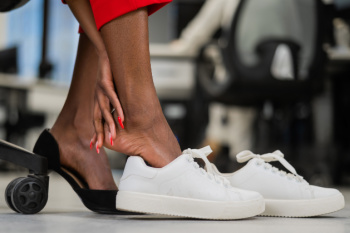Connect With Us
Blog

Foot and ankle stress fractures encompass various types, commonly occurring among athletes due to repetitive impact activities like running, jumping, or sudden changes in direction. These fractures result from the accumulation of microtrauma, leading to small cracks in the bones. Athletes often describe the sensation as a gradual onset of localized pain that worsens with activity and improves with rest. Stress fractures can occur in different areas of the foot and ankle, including the metatarsals, navicular, calcaneus, and fibula. Prompt diagnosis is important to prevent further damage and facilitate proper healing. If you have sustained a foot or ankle injury, it is suggested that you schedule an appointment with a podiatrist. A podiatrist can employ techniques like imaging studies, biomechanical assessments, and customized treatment plans. By providing targeted interventions and guidance on activity modification, podiatrists help shorten your time away from sports and expedite your return to activity with reduced risk of complications.
Activities where too much pressure is put on the feet can cause stress fractures. To learn more, contact Stephen Boykins, DPM from SoCal Podiatry, P.C.. Our doctor can provide the care you need to keep your pain free and on your feet.
Dealing with Stress Fractures of the Foot and Ankle
Stress fractures occur in the foot and ankle when muscles in these areas weaken from too much or too little use. The feet and ankles then lose support when walking or running from the impact of the ground. Since there is no protection, the bones receive the full impact of each step. Stress on the feet can cause cracks to form in the bones, thus creating stress fractures.
What Are Stress Fractures?
Stress fractures occur frequently in individuals whose daily activities cause great impact on the feet and ankles. Stress factors are most common among:
- Runners
- People affected with Osteoporosis
- Tennis or basketball players
- Gymnasts
- High impact workouts
Symptoms
Pain from the fractures occur in the area of the fractures and can be constant or intermittent. It will often cause sharp or dull pain with swelling and tenderness. Engaging in any kind of activity which involves high impact will aggravate pain.
If you have any questions please feel free to contact our offices located in Downey and Moreno Valley, CA . We offer the newest diagnostic and treatment technologies for all your foot and ankle needs.
 Athletes often experience heel pain due to the intense and repetitive stress placed on their feet during training. One common heel pain problem is plantar fasciitis, which is inflammation of the band of tissue running along the bottom of the foot. Another is Achilles tendonitis, which involves inflammation of the tendon that connects the calf muscles to the heel. These conditions can result from overuse, inadequate footwear, or improper training techniques. While most athletes respond well to conservative treatments like rest, stretches, and orthotics, there are times when these measures do not provide sufficient relief. In such cases, a podiatrist may suggest surgery as a last resort. Many factors go into deciding whether surgery is the best option, such as weighing the athlete's condition severity, pain levels, and impact on their performance and quality of life. If you are an athlete struggling with heel pain, it is suggested that you consult a podiatrist for a personalized treatment plan.
Athletes often experience heel pain due to the intense and repetitive stress placed on their feet during training. One common heel pain problem is plantar fasciitis, which is inflammation of the band of tissue running along the bottom of the foot. Another is Achilles tendonitis, which involves inflammation of the tendon that connects the calf muscles to the heel. These conditions can result from overuse, inadequate footwear, or improper training techniques. While most athletes respond well to conservative treatments like rest, stretches, and orthotics, there are times when these measures do not provide sufficient relief. In such cases, a podiatrist may suggest surgery as a last resort. Many factors go into deciding whether surgery is the best option, such as weighing the athlete's condition severity, pain levels, and impact on their performance and quality of life. If you are an athlete struggling with heel pain, it is suggested that you consult a podiatrist for a personalized treatment plan.
Many people suffer from bouts of heel pain. For more information, contact Stephen Boykins, DPM of SoCal Podiatry, P.C.. Our doctor can provide the care you need to keep you pain-free and on your feet.
Causes of Heel Pain
Heel pain is often associated with plantar fasciitis. The plantar fascia is a band of tissues that extends along the bottom of the foot. A rip or tear in this ligament can cause inflammation of the tissue.
Achilles tendonitis is another cause of heel pain. Inflammation of the Achilles tendon will cause pain from fractures and muscle tearing. Lack of flexibility is also another symptom.
Heel spurs are another cause of pain. When the tissues of the plantar fascia undergo a great deal of stress, it can lead to ligament separation from the heel bone, causing heel spurs.
Why Might Heel Pain Occur?
- Wearing ill-fitting shoes
- Wearing non-supportive shoes
- Weight change
- Excessive running
Treatments
Heel pain should be treated as soon as possible for immediate results. Keeping your feet in a stress-free environment will help. If you suffer from Achilles tendonitis or plantar fasciitis, applying ice will reduce the swelling. Stretching before an exercise like running will help the muscles. Using all these tips will help make heel pain a condition of the past.
If you have any questions please contact our offices located in Downey and Moreno Valley, CA . We offer the newest diagnostic and treatment technologies for all your foot and ankle needs.

Foot pain resulting from obesity can profoundly affect biomechanics and gait, as excess weight places undue stress on the feet, ankles, and lower limbs. This strain can alter the way you walk, leading to compensatory movements and further discomfort. Beyond physical discomfort, foot pain caused by obesity can significantly impact daily life, hindering mobility and limiting participation in activities. Seeking help from a podiatrist offers compassionate support and effective solutions for anyone suffering foot problems related to their weight. Podiatrists understand the complexities of foot pain associated with obesity and can provide personalized care to address your unique needs. They offer a range of treatments, including orthotic devices to support proper alignment and footwear guidance to alleviate pressure. If you carry excess weight and have foot pain, it is suggested that you schedule an appointment with a podiatrist so you can embark on a journey toward improved foot health and enhanced overall well-being.
The more you weigh, the harder your feet must work to support your body. If you’re an obese individual and are concerned about your feet, contact Stephen Boykins, DPM from SoCal Podiatry, P.C.. Our doctor can provide the care you need to keep you pain-free and on your feet.
Obesity and Your Feet
People who are overweight are putting more pressure on their ankles, knees, and hips as well as their feet. This unfortunately can lead to variety of different issues.
Problems & Complications Stemming from Obesity
- When the body is overweight, it tries to compensate by changing the way that it moves. An obese person may lean forward and put extra weight on the wrong part of the foot. This puts unnecessary stress on the feet.
- Obese people are also more likely to develop type II diabetes which is a condition that causes a lot of foot problems. People with diabetes often don’t feel the cuts and sores that they may have on their feet, which can lead to more complicated and severe issues.
- Plantar fasciitis is another foot condition that can be caused by obesity. Plantar fasciitis is an inflammation of the tissue along the bottom of the foot, which causes pain and stiffness while walking and climbing stairs.
If you have any questions, please feel free to contact our offices located in Downey and Moreno Valley, CA . We offer the newest diagnostic and treatment technologies for all your foot care needs.

